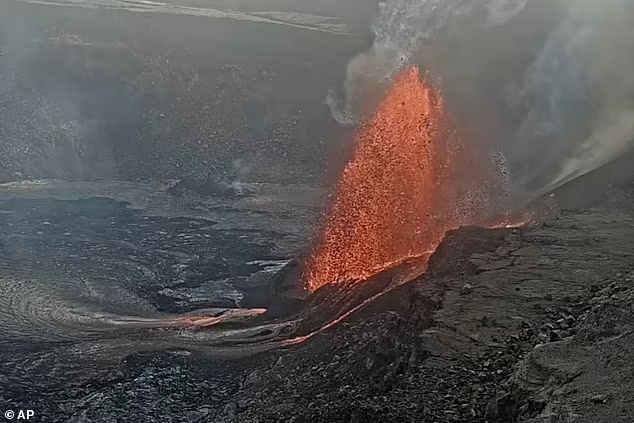
Lava Fountains Reach 330 Feet as Kīlauea’s Eruption Draws Visitors, Triggers Health Warnings. (Pic: AP)
(EPICSTORIAN) — Lava fountains soared as high as 330 feet after Kīlauea volcano on Hawaii’s Big Island erupted again on February 11, 2025.
The activity, which began at 10:16 a.m. local time, has continued with bursts of molten rock and volcanic gas from the Halemaʻumaʻu Crater inside Hawaiʻi Volcanoes National Park.
The U.S. Geological Survey’s Hawaiian Volcano Observatory (HVO) confirmed the eruption, warning of potential hazards.
“Current risks include volcanic gas emissions and windblown volcanic glass, also known as Pele’s Hair, which could affect the national park and nearby communities,” the agency stated.
Lava remains confined to the summit crater, keeping residential areas out of immediate danger. Tourists have flocked to the park’s viewing areas to witness the eruption, though authorities urge caution due to air quality concerns.
Sulfur dioxide levels remain elevated, which can lead to respiratory issues, headaches, and dizziness. The Centers for Disease Control and Prevention (CDC) warns that prolonged exposure may contribute to lung diseases, including bronchitis.
Fine volcanic glass fibers, known as Pele’s Hair, present another challenge. These delicate but sharp strands form when gas bubbles in lava burst at the surface. Strong winds can carry them over long distances, causing skin and eye irritation or contaminating drinking water.
Kīlauea is one of the world’s most active volcanoes, frequently erupting since December 23, 2024. Earlier episodes have lasted between 13 hours and eight days.
Scientists from the University of Hawaiʻi at Mānoa have linked the volcano’s recent activity to a shared magma source with Mauna Loa, the largest volcano on Earth. Research suggests that when one receives an influx of magma, its activity intensifies while the other remains quieter.
Kīlauea’s longest and most destructive eruption stretched from 1983 to 2018, destroying entire towns and a famous black sand beach. Today’s eruption is significantly smaller, but scientists continue to monitor seismic activity for any signs of escalation.
Authorities advise residents and visitors to stay informed through official channels and follow safety guidelines.
Also Read: Massive Landslide in Sichuan Buries Homes, Dozens Still Missing
The Hawaiian Volcano Observatory provides live updates, and Hawaiʻi Volcanoes National Park remains open, though visitors are encouraged to wear protective masks and avoid prolonged exposure to volcanic fumes.







